

Numerology. Numbers. List of numbers. Rational numbers[edit] Natural numbers[edit] Powers of ten (scientific notation)[edit] Integers[edit] Notable integers[edit] Other numbers that are notable for their mathematical properties or cultural meanings include: Named integers[edit] Prime numbers[edit] A prime number is a positive integer which has exactly two divisors: one and itself.
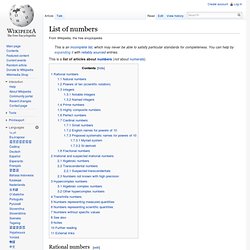
Highly composite numbers[edit] A highly composite number (HCN) is a positive integer with more divisors than any smaller positive integer. 1 (number) The glyph used today in the Western world to represent the number 1, a vertical line, often with a serif at the top and sometimes a short horizontal line at the bottom, traces its roots back to the Indians, who wrote 1 as a horizontal line, much like the Chinese character 一.
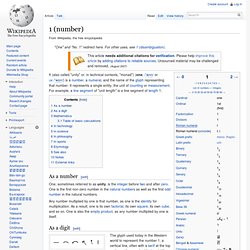
The Gupta wrote it as a curved line, and the Nagari sometimes added a small circle on the left (rotated a quarter turn to the right, this 9-look-alike became the present day numeral 1 in the Gujarati and Punjabi scripts). The Nepali also rotated it to the right but kept the circle small.[1] This eventually became the top serif in the modern numeral, but the occasional short horizontal line at the bottom probably originates from similarity with the Roman numeral . In some European (e.g., Germany) and Asian (e.g., Israel) countries, the little serif at the top is sometimes extended into a long upstroke, sometimes as long as the vertical line, which can lead to confusion with the glyph for seven in other countries. . 2 (number) 2 (Two; .
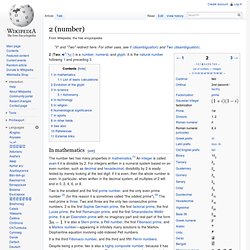
3 (number) It is frequently noted by historians of numbers that early counting systems often relied on the three-patterned concept of "One, Two, Many" to describe counting limits.

Early peoples had a word to describe the quantities of one and two, but any quantity beyond was simply denoted as "Many". As an extension to this insight, it can also be noted that early counting systems appear to have had limits at the numerals 2, 3, and 4. References to counting limits beyond these three do not appear to prevail as consistently in the historical record. Three is the largest number still written with as many lines as the number represents. (The Ancient Romans usually wrote 4 as IIII, but this was almost entirely replaced by the subtractive notation IV in the Middle Ages.) . Many world religions contain triple deities or concepts of trinity, including:
4 (number) 5 (number) 6 (number) The SI prefix for 10006 is exa (E), and for its reciprocal atto- (a).

Since six equals the sum of its proper divisors, six is the smallest perfect number, Granville number, and -perfect number.[1][2] As a perfect number: Six is the only number that is both the sum and the product of three consecutive positive numbers.[4] Unrelated to 6 being a perfect number, a Golomb ruler of length 6 is a "perfect ruler Six is the first discrete biprime (2.3) and the first member of the (2.q) discrete biprime family. 5 and 6 form a Ruth-Aaron pair under either definition. 6 is the largest of the four all-Harshad numbers. There are six basic trigonometric functions. There are six convex regular polytopes in four dimensions. 7 (number) In fact, if one sorts the digits in the number 142857 in ascending order, 124578, it is possible to know from which of the digits the decimal part of the number is going to begin with.

The remainder of dividing any number by 7 will give the position in the sequence 124578 that the decimal part of the resulting number will start. For example, 628/7= 89 + 5/7; here 5 is the remainder, and would correspond to number 7 in the ranking of the ascending sequence. 8 (number) 9 (number) In the NATO phonetic alphabet, the digit 9 is called "Niner".Five-digit produce PLU codes that begin with 9 are organic.
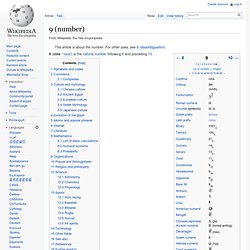
Common terminal digit in psychological pricing Nine Lives cat food; its name is derived from the legend that a cat has nine livesNine Network a.k.a. Channel 9, an Australian free-to-air television stationNine West, a clothing brand [1] 10 (number) 10 (ten A collection of ten items (most often ten years) is called a decade.The ordinal adjective is denary.Increasing a quantity by one order of magnitude is most widely understood to mean multiplying the quantity by ten.To reduce something by one-tenth is to decimate.
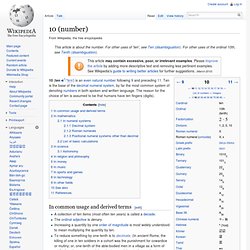
(In ancient Rome, the killing of one in ten soldiers in a cohort was the punishment for cowardice or mutiny; or, one-tenth of the able-bodied men in a village as a form of retribution, thus causing a labor shortage and threat of starvation in agrarian societies.)With ten being the base of the decimal system, a scale of 1 to 10 is often used to rank things, as a smaller version of a 1-to-100 scale (as is used in percentages and wine-tasting). 11 (number) 11 (eleven In English, it is the smallest positive integer requiring three syllables and the largest prime number with a single-morpheme name.
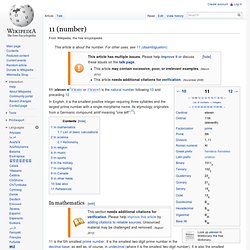
Its etymology originates from a Germanic compound ainlif meaning "one left".[1]). If a number is divisible by 11, reversing its digits will result in another multiple of 11. As long as no two adjacent digits of a number added together exceed 9, then multiplying the number by 11, reversing the digits of the product, and dividing that new number by 11, will yield a number that is the reverse of the original number.
(For example: 142,312 x 11 = 1,565,432. 2,345,651 / 11 = 213,241.) 12 (number) 12 (twelve A group of twelve things is called a duodecad.
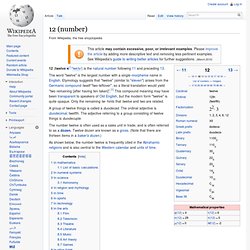
The ordinal adjective is duodecimal, twelfth. The adjective referring to a group consisting of twelve things is duodecuple. As shown below, the number twelve is frequently cited in the Abrahamic religions and is also central to the Western calendar and units of time. Numbers. A notational symbol that represents a number is called a numeral. In addition to their use in counting and measuring, numerals are often used for labels (telephone numbers), for ordering (serial numbers), and for codes (e.g., ISBNs). Classification of numbers[edit] Natural numbers[edit] The most familiar numbers are the natural numbers or counting numbers: 1, 2, 3, and so on. Mighty Number. Numerology.
Numbers_2.jpg (342×380)